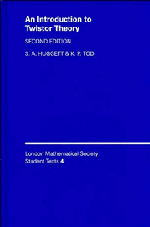Book contents
- Frontmatter
- Contents
- Preface
- Preface to the second edition
- 1 Introduction
- 2 Review of Tensor Algebra and Calculus
- 3 Lorentzian Spinors at a Point
- 4 Spinor Fields
- 5 Compactified Minkowski Space
- 6 The Geometry of Null Congruences
- 7 The Geometry of Twistor Space
- 8 Solving the Zero Rest Mass Equations I
- 9 Sheaf Cohomology and Free Fields
- 10 Solving the Zero Rest Mass Equations II
- 11 The Twisted Photon and Yang–Mills Constructions
- 12 The Non-Linear Graviton
- 13 Penrose's Quasi-Local Momentum and Angular Momentum
- 14 Functionals on Zero Rest Mass Fields
- 15 Further Developments and Conclusions
- 16 Hints, Solutions and Notes to the Exercises
- Appendix The GHP Equations
- Bibliography
- Index
14 - Functionals on Zero Rest Mass Fields
Published online by Cambridge University Press: 25 January 2010
- Frontmatter
- Contents
- Preface
- Preface to the second edition
- 1 Introduction
- 2 Review of Tensor Algebra and Calculus
- 3 Lorentzian Spinors at a Point
- 4 Spinor Fields
- 5 Compactified Minkowski Space
- 6 The Geometry of Null Congruences
- 7 The Geometry of Twistor Space
- 8 Solving the Zero Rest Mass Equations I
- 9 Sheaf Cohomology and Free Fields
- 10 Solving the Zero Rest Mass Equations II
- 11 The Twisted Photon and Yang–Mills Constructions
- 12 The Non-Linear Graviton
- 13 Penrose's Quasi-Local Momentum and Angular Momentum
- 14 Functionals on Zero Rest Mass Fields
- 15 Further Developments and Conclusions
- 16 Hints, Solutions and Notes to the Exercises
- Appendix The GHP Equations
- Bibliography
- Index
Summary
Given the powerful constructions of chapters 8–10, which show how the Penrose transform describes zero rest mass fields and neatly geometrises the concept of positive frequency, it is natural to seek a twistor description of interactions. One might expect such a description to arise out of a twistor dynamical principle, replacing the usual space-time Lagrangian, and indeed the early work (Penrose and MacCallum 1972) proceeded in just this way, the resulting twistor integrals being referred to as twistor diagrams. Twistor diagrams share with Feynmann diagrams a simple combinatorial structure, but are not supposed to share their divergences! The analogy between twistor diagrams and Feynmann diagrams has been extensively explored, for which see Hodges (1990) and references therein. In this work twistor diagrams are regarded as determining integrals of holomorphic functions over compact contours, and it is only fairly recently that the diagrams have been reinterpreted as functionals on the cohomology classes representing the fields. This latter question, which is reviewed in Huggett (1990), is our subject here, and in order to discuss it adequately we will need to draw on some more cohomology theory. We start, however, by making a relatively simple observation on the geometry of products of twistor spaces.
In the product space {(Zα, Wα) ∈ PT × PT* : ZαWα ≠ 0} the following holomorphic differential forms arise quite naturally. Let DZ = ∈αβδγZαdZβdZδdZγ, where ∈αβδγ is as in (7.7), define DW similarly and let DZW be their wedge product.
- Type
- Chapter
- Information
- An Introduction to Twistor Theory , pp. 137 - 146Publisher: Cambridge University PressPrint publication year: 1994



